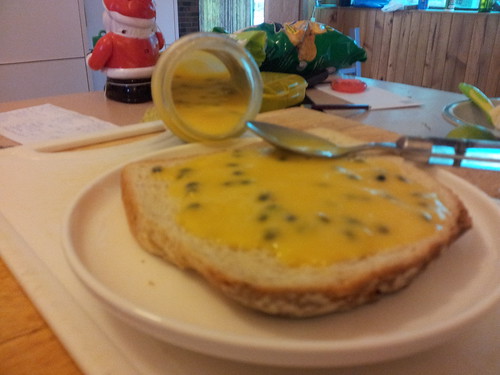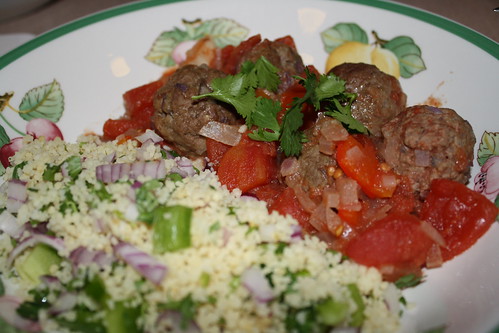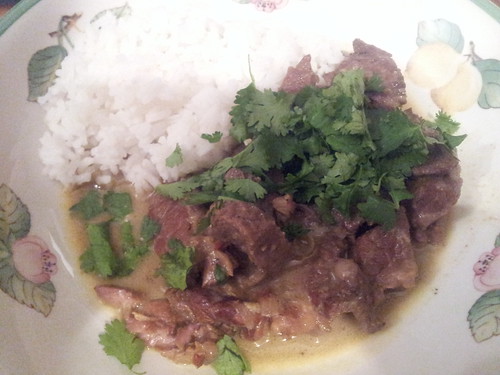As you might have noticed, Eating Adelaide is not a blog filled with amazing pictures of food. But I think with my attempt at a photo of my passionfruit curd, I’ve sunk to a new low in photographic rubbishness!
I’d already put the curd in jars: labels still on and narrow necks. On my piece of bread the curd looked flat and kind of uniformly yellow. I tried tilting a jar over, I tried photographing it so you couldn’t tell what had been in the jar before the curd, I tried using the flash, no flash, my phone’s camera, I even got the tripod out.
And it still looks terrible.
All the while, my tummy rumbled and it didn’t take too much to give up on the photography and eat the piece of bread.
I don’t get these people who have the patience to mess around styling and photographing their food. I make it and then I want to eat it. And that’s why you get to enjoy such dodgy photos!
A friend has a mature, and huge, passionfruit vine which occupies a good chunk of his back garden. Which means I was lucky enough to have a big bag of passionfruit delivered to me.
At the time it was quite hot, so turning on the oven didn’t appeal. That – and I would have had to have made a ton of cakes, slices and biscuits in order to make a dent in the pile of passionfruit.
Fortunately, passionfruit curd requires no oven and needs lots of the little beggars.
I read a selection of recipes online and they were all vaguely similar. There was slight variation in the ratio of whole eggs to egg yolks, some used a double boiler, some didn’t, one even used the microwave.
One thing they all had in common was I thought they contained far too much sugar. So I made up my own recipe and figured that really, it would all work out in the end.
I do love being right!
Begin by beating two eggs, two egg yolks and 100g of caster sugar. Beat until reasonably light and fluffy. I didn’t this by hand and I’d describe the mixture as combined but not approaching that thick, pale ribbon stage you aim for if you’re making a proper custard.
On the stove, melt 125g of unsalted butter. When the butter is melted, whisk 160mL of passionfruit pulp (this is probably around 8-10 fruit although they vary in size so it’s a bit tough to give you a number) through the eggs and pour it into the pan with the butter. HAVE THE HEAT VERY LOW. I cannot stress that enough. LOW. REALLY LOW!
Now you have to stand and stir. You don’t have to stir vigorously, but you do have to keep stirring. Have someone make you a cup of tea or pour you a glass of wine. Whatever you do, don’t crank the heat up to hurry things along. That way certain failure lies.
So you stand there stirring, stirring, stirring. And basically you keep on doing that until the mix turns to the consistency of custard (that is, you draw a line with your finger through the curd on the back of a spoon and the curd does not close back on itself). You don’t need for it to be super thick because it will thicken further as it chills.
I think all up this took about 20 minutes for me. It was a hot evening, and even though the stove was only on low, I got very hot standing there and it felt like it was about three hours!
Sterilise a couple of jars (make sure they’re well washed and then pour boiling water into them). Pour the hot curd into the jars, pop the lids on but don’t do them up.
Once the curd has cooled in the jars, tighten the lids and refrigerate.
I ended up with 2 190mL jars of curd.
If you want, you can loosen the seeds from the pulp by giving it a very quick blast in a food processor and then sieving them out. I couldn’t be bothered.
Eat on bread or toast. Use as part of a pavlova topping. Sandwich meringues together with it. Fill macarons with it. Or just go back to eating it on bread.
Delicious and not too sweet. Very easy to make but patience is required!



